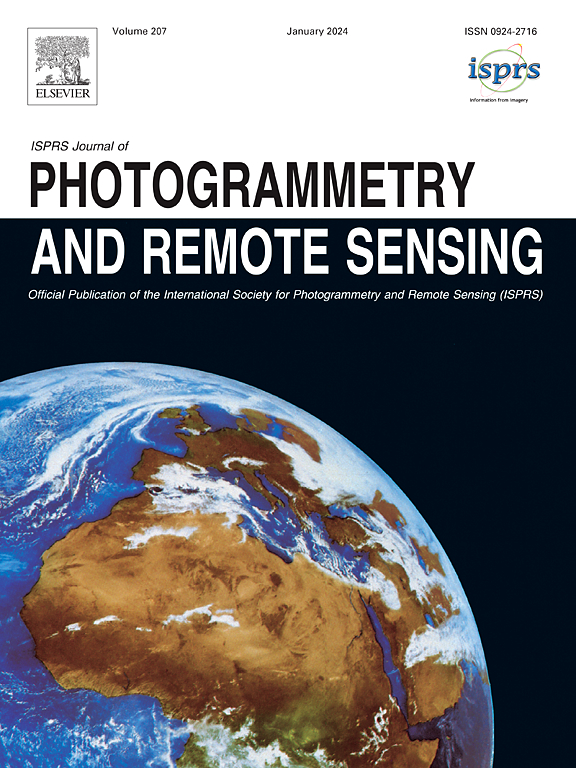Time-Series models for ground subsidence and heave over permafrost in InSAR Processing: A comprehensive assessment and new improvement
IF 10.6
1区 地球科学
Q1 GEOGRAPHY, PHYSICAL
ISPRS Journal of Photogrammetry and Remote Sensing
Pub Date : 2025-03-02
DOI:10.1016/j.isprsjprs.2025.02.019
引用次数: 0
Abstract
InSAR is an effective tool for indirectly monitoring large-scale hydrological-thermal dynamics of the active layer and permafrost by detecting the surface deformation. However, the conventional time-series models of InSAR technology do not consider the distinctive and pronounced seasonal characteristics of deformation over permafrost. Although permafrost-tailored models have been developed, their performance relative to the conventional models has not been assessed. In this study, we modify sinusoidal function and Stefan-equation-based models (permafrost-tailored) to better characterize surface deformation over permafrost, and assess advantages and limitations of these models for three application scenarios: filling time-series gaps for Small Baseline Subset (SBAS) inversion, deriving velocity and amplitude of deformation and selecting reference points automatically. The HyP3 interferograms generated from Sentinel-1 are utilized to analyze the surface deformation of the permafrost region over the upper reaches of the Heihe River Basin from 2017 to 2023. The result shows that adding a semi-annual component to the sinusoidal function can better capture the characteristics of ground surface deformation in permafrost regions. The modified Stefan-equation-based model performs well in those application scenarios, but it is only recommended for complex scenarios that conventional mathematical models cannot handle or for detailed simulations at individual points due to sophisticated data preparation and high computational cost. Furthermore, we find reference points can introduce substantial uncertainties into the deformation velocity and amplitude measurements, in comparison to the uncertainties derived from interferograms alone. The analysis of deformation amplitude and inter-annual velocity reveals that an ice-rich permafrost region, exhibiting a seasonal amplitude of 50–130 mm, is experiencing rapid degradation characterized by a subsidence velocity ranging from −10 to −20 mm/yr. Our study gives a permafrost-tailored modification and quantitative assessment on the InSAR time-series models. It can also serve as a reference and promotion for the application of InSAR technology in future permafrost research. The dataset and code are available at https://github.com/Fanchengyan/FanInSAR.
InSAR 处理中冻土层地面沉降和隆起的时间序列模型:全面评估和新的改进
本文章由计算机程序翻译,如有差异,请以英文原文为准。
求助全文
约1分钟内获得全文
求助全文
来源期刊

ISPRS Journal of Photogrammetry and Remote Sensing
工程技术-成像科学与照相技术
CiteScore
21.00
自引率
6.30%
发文量
273
审稿时长
40 days
期刊介绍:
The ISPRS Journal of Photogrammetry and Remote Sensing (P&RS) serves as the official journal of the International Society for Photogrammetry and Remote Sensing (ISPRS). It acts as a platform for scientists and professionals worldwide who are involved in various disciplines that utilize photogrammetry, remote sensing, spatial information systems, computer vision, and related fields. The journal aims to facilitate communication and dissemination of advancements in these disciplines, while also acting as a comprehensive source of reference and archive.
P&RS endeavors to publish high-quality, peer-reviewed research papers that are preferably original and have not been published before. These papers can cover scientific/research, technological development, or application/practical aspects. Additionally, the journal welcomes papers that are based on presentations from ISPRS meetings, as long as they are considered significant contributions to the aforementioned fields.
In particular, P&RS encourages the submission of papers that are of broad scientific interest, showcase innovative applications (especially in emerging fields), have an interdisciplinary focus, discuss topics that have received limited attention in P&RS or related journals, or explore new directions in scientific or professional realms. It is preferred that theoretical papers include practical applications, while papers focusing on systems and applications should include a theoretical background.
 求助内容:
求助内容: 应助结果提醒方式:
应助结果提醒方式:


